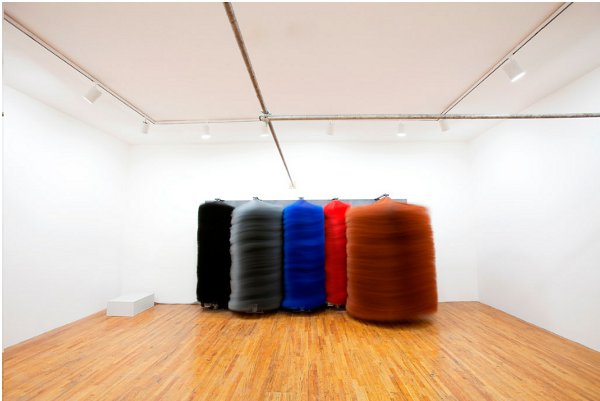Artist Lara Favaretto Celebrates the Absurd and Existentially Tragic at MoMA PS1

Located somewhere in the vast landscape of human emotion is the intersection of playfulness and sadness, a crossroads at which Italian artist Lara Favaretto has set up shop to ply her trade. Over the past 15 years, she has amassed a body of work that explores and celebrates the absurd and the existentially tragic, at once delighting her audience and musing on death, decay and obsolescence. In the first-ever survey of her work, Lara Favaretto: Just Knocked Out, MoMA PS1 has given over several of its galleries to the display of her most important works to date, including a site-specific installation in the museum’s atrium and another throughout the exhibition.
The unconventional space of MoMA PS1, a converted Romanesque Revival public school located in Long Island City, NY, lends itself to the kind of large-scale installations that characterize Favaretto’s work. From a balcony on the museum’s ground floor, visitors gaze down at the kinetic madness of Plotone (Platoon), an army of compressed air tanks with pressure regulators that alternately inflate noiseless party whistles. As the pressure builds (both literally and figuratively) and a whistle inflates, expectations are dashed when it finally deflates, having never achieved that satisfying New Year’s honk.
In an adjacent room, a packed earthen floor obscures the memory of a man named Albert Dadas, who spent his life travelling but sadly not retaining the memory. Buried under the soil, a metal box lies hidden, containing the remaining evidence of his existence. Favaretto began the series she calls “momentary monuments” with her famed swamp in the back of the Giardini in Venice in which she memorialized 20 historical figures who have disappeared.
Also on exhibition is a recent piece from a series in which she mummified a found painting, trapping the image inside the wrapped wool, forever erasing it from existence. This idea is a continuation of a project in which she entombed lost luggage, preserving but also obscuring the contents from the possibility of discovery.

Present overhead throughout the many galleries of the exhibition, the site-specific Grid after Piet Mondrian, Composition with Red, Yellow and Blue, 1921, formed of aluminum piping lined with dyed wool yarn, lend a unifying framework to the disparate media of Favaretto’s other installations.
Mondrian was famous for his hard-edge abstract compositions that employed the limited palette of black lines on white background and just the three primary colors of red, yellow and blue. Favaretto’s scaffolding appears to be no more than just that, a series of interlocking black pipes, when seen within the limits of a single gallery room. Taken together, as pieces that comprise a whole, the pipes combine to reproduce Mondrian’s painting. Each pipe has a circular cut through which the colored strands of yarn are visible. The subtlety of the small exposure within the structure adds to a sense of adventure, as each new room offers a challenge to identify the intended color fields.

Beneath the hanging scaffolding pipes of Favaretto’s Mondrian homage, the whirling excitement of a group of car wash brushes provides a kinetic counterpoint to the stark rigidity overhead. Gummo achieves a graduated response, taking the viewer from the thrill of first encountering the spinning brushes to the realization that their movement is necessarily in conflict with their position in relation to the wall and to the other brushes around them. With every spin, the bristles wear down further as they hit metal plates affixed to the wall. Something poignant is conveyed in the fatalistic existence of these hapless automatons, constantly furthering their own obsolescence through the tragedy of their own function.
Nearby, piles of rainbow confetti are blown around a sealed room by a series of desk fans. The air glitters with tiny bits of paper that fall into place amid the mountains below. The fans twist around the room, slowly eroding the confetti piles, dislodging enough of the pieces to send a colorful display up into the air. Onlookers watch through a locked glass door, unable to engage further with what is a decidedly appealing spectacle.
Before leaving the exhibition, visitors are invited to choose one of the abandoned books from a large bookcase in the lobby. Hidden in the pages of each book is a reproduction of an image that Favaretto has collected as source material throughout her career. Walking out of the museum with a book under arm, visitors are connected with the paradoxical delight of experiencing Favaretto’s work, in the face of a constant sense of depletion, obsolescence and loss.
*Lara Favaretto: Just Knocked Out is on exhibition at MoMA PS1 in New York through September 10, 2012.
All photos: MoMA PS1
Author Bio:
Eric Russ is Highbrow Magazine’s chief art critic. He attended New York University, where he received a Bachelor’s Degree in ‘The Sense of Self,’ an interdisciplinary investigation of human identity. He holds a Master’s Degree in Art Business from the Sotheby’s Institute of Art.




























































































































































































































































































































